Stratodesk NoTouch has the latest version of Citrix Workspace App (formerly Citrix Receiver) integrated. Our Citrix Workspace App implementation supports both ICA and HDX, as well as Flash, multimedia and USB redirection, making a perfect Citrix endpoint solution, without any need for installing software, cryptic configuration files or command line options! NoTouch provides a complete configuration environment for Citrix Workspace App, so it is not necessary to directly work with Citrix' own configuration - everything can be configured and managed via the local NoTouch configuration menu as well as centrally with NoTouch Center. The Citrix Workspace Hub also uses Citrix Workspace App.
This article gives an overview of the different configuration scenarios and later describes Citrix product specific configuration steps. We assume that you basically understand how NoTouch OS is configured and especially how server connections are created and configured. The Citrix Receiver for Linux differs in many aspects from the Windows-based Receiver, not only in terms of look-and-feel, but also in terms of available features and even bugs.
Contents
- 1 Citrix configuration scenarios in NoTouch
- 2 Common configuration scenarios
- 3 HTTPS/SSL and certificates
- 4 USB forwarding
- 5 Browser Content Redirection (BCR)
- 6 HDX and Multimedia support
- 7 Smartcard support
- 8 Advanced configuration
Citrix configuration scenarios in NoTouch
The following options are available how to configure the system:
- Go directly into one published resource, e.g. a fullscreen desktop
- Present a choice to users for multiple available resources, e.g. published applications
- Use Firefox or Chromium web browsers and log in via browser
- Use the "selfservice" GUI to provide a browser-like experience
- #How to create a connection to Citrix Cloud
Browser-based login
If you want to log in via browser, create a connection, use either Firefox or Chromium, and point it to your Citrix URL.
On most modern PCs a browser is a good choice, and NoTouch cleans out the environment after the browser is closed. On older systems or the Raspberry Pi you may find a browser solely for the purpose of logging in uses too many resources, though.
Newer browsers don't support the Citrix plugin any more. No worries, everything is set up properly on NoTouch OS for both Firefox and Chromium. You may have to review https://support.citrix.com/article/CTX237727 to set it up for your Citrix environment.
Citrix Workspace App
In most cases a connection of type Citrix Workspace App and a Citrix URL as connection target are enough to successfully run a Citrix client.
"Citrix Workspace App", the mode of choice for using NoTouch with both on-premise and cloud-based Citrix deployments, including Citrix Workspace. It can be used to either run one resource (absolutely seamless to the end user) or show a menu where users can choose from - at your option!
If you want to connect to sites using the older PNA protocol or any earlier Citrix products, please visit Legacy Citrix configuration.
Note: Before version 2.40.4680 (i.e. end of 2018), the Citrix Workspace App connection mode was called Citrix/StoreFront
Creating a StoreFront connection
Setting up a connection to Citrix is really easy. Follow these simple steps:
- Create a connection
- Set its Connection Mode parameter to "Citrix Workspace App" (older versions call this "Citrix/StoreFront")
- Set the Citrix StoreFront URL into the Connection Target parameter
- Use the real StoreFront API URL, typically like /Citrix/Store (as opposed to the user/web browser URL that ends in /StoreWeb)
- You can also use the Citrix URL parameter of the Citrix options instead of Connection Target - both parameters work equally well
- Make sure the client has access to all necessary Certificates. StoreFront is SSL-only, it is mandatory to have proper CA root certificates!
NoTouch will display a chooser if more than one published resources are available (otherwise, if it is only one, it will launch that without further questioning). If you want to go directly into one resource, please read below.
Note: The Citrix Workspace App will display a choice between different stores. That is especially common if going through a NetScaler that bundles multiple stores. To avoid that, you must set up your URLs that it goes to one store. It is really all depending on the URL and the server configuration.
Starting directly into a specific application or desktop
If you want to start a specific resource instead of showing a chooser:
- Set it into the Launch Resource parameter of the Citrix options, or
- Make sure Citrix StoreFront offers only one resource. In that case, NoTouch will start the single available resource automatically.
Logoff timeout
By default NoTouch will close the StoreFront connection immediately after the actual published application or desktop is closed. This is expected in 99% of all use cases - you don't want your users to log off from a Windows desktop, walk away from the workstation but leave the StoreFront chooser open for anybody else...
However, if your use case is different, you can modify the StoreFront stay logged in parameter in the Citrix options. It is 0 by default (=immediate termination), any number of seconds is ok. Thus, if you type in 120, you would give your users two minutes (120 seconds) time to choose another connection out of the chooser window.
How to create a connection to Citrix Cloud
To get the Citrix Workspace experience, you can create your connection in the same way you would do normally by selecting the connection mode ‘Workspace App’ and adding the connection target URL.
In addition to this and to achieve the Citrix Workspace experience you will need to configure a number of Selfservice parameters which visible under the ‘Citrix Workspace App’ parameters of your connection. There are a number of options here, but those shown below give you the ability to interact with multiple published applications on the Stratodesk Desktop. If however, you launch a desktop, then this will launch in full screen.
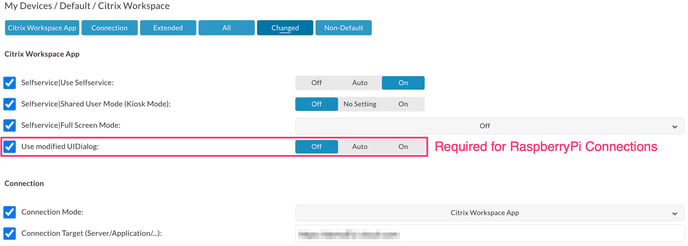
If you are connecting to Citrix Workspace from a Citrix Ready Workspace Hub or Raspberry Pi then you should also include the parameter ‘Use Modified UIDialog’ and set this to ‘off’ as shown above.
Once you have announced the change, you should see the icon appear on the desktop and be able to launch the connection. Please enter your username & password.
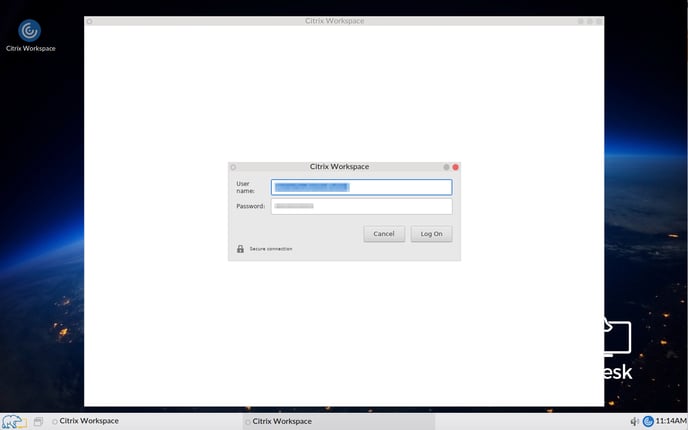
If authentication has been successful you should have visibility of your Citrix Workspace environment.
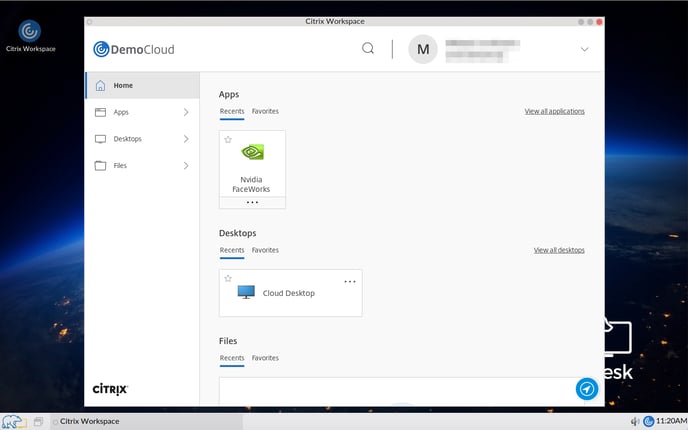
Important
It is worth noting that the current version of the Linux Workspace App 20.04.0.21 included in NoTouch OS version 4.2.6 does not include Intelligent Workspace Features, please see the following matrix published by Citrix https://www.citrix.com/content/dam/citrix/en_us/documents/data-sheet/citrix-workspace-app-feature-matrix.pdf
As and when these features become available as part of the Linux Workspace App then these will be included in future releases as part of a firmware update.
Common configuration scenarios
Desktop Viewer Toolbar
The Desktop Viewer Toolbar is an overlay menu that allows to quickly end or modify a Citrix session. You can switch it off. Usually system administrators like it, but end users not so much.
The Raspberry Pi can display the Desktop Viewer Toolbar only when NOT in H.264 mode. That means, if you want it on the Raspberry Pi, you have to both disable H.264 and enable the Desktop Viewer Toolbar.
Help! It's not fullscreen!
Connection modes Citrix/One application or desktop and Citrix/Program Neighborhood as well as connecting to Citrix via browser means that the actual session specification will be created on the server. This includes for example the window size. It is not possible to modify such settings from the client side - you must do it in the Citrix management console, e.g. setting the "window size" to Fullscreen.
Multimonitor/Dualscreen operation
The Citrix Receiver will take advantage of multiple monitors automatically and it will report screen geometry to the server. Please make sure Multimonitor support works, more information can be found here: Multimonitor operation with NoTouch
Two parameters influence the dualmonitor/multimonitor behavior - the effects of these parameters are entirely up to Citrix and may change with different versions of the Citrix client:
- Use screens (span)
- Default. This is the default. All monitors are available will be used if present.
- All. Force using all monitors.
- No setting. NoTouch will not set this parameter at all when launching the Citrix client.
- Custom. The values from the "Custom span parameter" will be taken.
- Custom span parameter (only if "Use screens" is set to custom. The following excerpt is from the Citrix manual:
-span [h[[o][a|mon1[,m2[,m3,m4]]] Set monitor spanning of full-screen sessions.
Most people will be fine with default settings, both in single- and in dual-monitor setups.
HTTPS/SSL and certificates
To operate Citrix Receiver properly with HTTPS connections, it must trust your StoreFront site's CA root certificate. In case you have publicly available Citrix URL you will most likely have used a well-known certification authority (CA) whose certificates are already in the system's trusted certificate store. On private, internal sites however you might use a self-signed certificate or one signed by your (private) Microsoft Active Directory Certification Service. In these latter cases, you must make the certification authority's (CA) root certificate available to NoTouch via the mechanisms defined in documentation on certificates.
- Citrix does not accept SHA-1 certificates. SHA2 (e.g. SHA256) is required.
- If your server certificate was signed by a sub-CA, the server must send the certificate chain or you must supply the intermediate CA certificates. This is a very common problem.
- Certificates you upload must be named .crt and be in human-readable form (starting with ---- BEGIN CERTIFICATE ---, what is called 'Base64-encoded DER'). If the file you plan to upload is not human-readable, you are using the wrong format.
- Please avoid having whitespaces and non-ASCII characters in the file name (no accented characters, no umlauts)
The Citrix Receiver for Linux does not have any switch to simply ignore the certificate check. That means you can not just turn the checks off. This is a Citrix policy (or "limitation", depending on your point of view).
For more information please see the article on Certificates.
USB forwarding
Blog: USB Redirection with the Citrix Workspace App for Linux
By default, USB forwarding is switched to on and USB devices will be forwarded to the server automatically. So called HIDs (human interface devices, such as keyboards, mice, but also mouse-emulating devices like digital dictation foot pedals) will not be forwarded, but rather handled locally and brought to the VDI desktop as keystrokes and mouse movements.
There are two parameters, both need to be enabled for USB forwarding to work (yes, the default is that both are on):
- "Citrix USB forwarder" in the "Services" section
- "Generic USB forwarding" in the ICA parameters section of the actual connection.
The Citrix USB forwarder is a system service, thus it can be configured from the "Services" parameters, not the Citrix ICA connection parameters. The startup behavior is controlled by the parameter named "Citrix USB forwarder" parameter. It has these options:
- "with Citrix connection". This is the default. Start the Citrix USB forwarder only if there is a Citrix connection configured.
- "off". Do not start the Citrix USB forwarder.
- "on". Start the Citrix USB forwarder after system boot.
Futhermore, you can allow or deny specific devices by using the "Allow devices" and "Deny devices" parameters in the "Services"/"Citrix USB" parameters. These parameters directly modify Citrix' usb.conf file and thus accept the original Citrix syntax only [1]. Multiple stanzas, each one describing one device, stanzas separated by commas, can be added to either of these parameters. A stanza consists of tags that in turn have the form TAG=VALUE. Acceptable tags are:
- VID Vendor ID from the device descriptor
- REL Release ID from the device descriptor
- PID Product ID from the device descriptor
- Class Class from either the device descriptor or an interface descriptor
- SubClass SubClass from either the device descriptor or an interface descriptor
- Prot Protocol from either the device descriptor or an interface descriptor
Valid examples for either of the two parameters are:
- VID=1460 PID=0008
- Class=07 SubClass=06
The Information page of the local configuration application will present information about USB devices to you - this is the place how you can find out the VID or PID, for instance. Command line afficionados will prefer the lsusb command, preferably in lsusb -v form.
Please see the original Citrix documentation for more information [2]. Changes to these parameters need a reboot to become active.
- "Desktop Appliance Mode"
Using Desktop Appliance Mode USB devices are also automatically redirected.
Browser Content Redirection (BCR)
Browser Content Redirection (BCR) is a Citrix feature to use the local, client CPU to render certain webpages instead of the VDA side. In other words, instead of the VDA side rendering the whole page, a Workspace-App-side rendering engine will be started and instructed to fetch the web content from the URL, render it locally and draw it into the browser window "over" the rest of the Citrix session.
On the NoTouch side, BCR needs to be switched on with the "Browser Content Redirection" parameter under the Citrix Workspace App options - set it to "on". On the Citrix side, you'll have to deal with
- certain Citrix policies,
- browser plugin installation,
- URL whitelisting (only whitelisted URLs will be redirected).
Raspberry Pi notes: Please see below in the "Raspberry Pi" section.
More information can be found here: Browser Content Redirection and Troubleshoot Browser Content Redirection
Needless to say, all required components for BCR are part of Stratodesk NoTouch OS. You do not need to worry about installing GStreamer, WebKitGtk+, CEF etc.
To use BCR with multimedia content on x86/PC platforms, you will most probably need the Fluendo codec pack. As of WSA 19.06, Citrix can not simply work with "only free codecs". See below for a more detailed explanation on the codec question.
Codecs
A codec in this context is a program to play back a certain kind of video or audio stream. Stratodesk NoTouch OS only includes codecs that are free from any patent license fees. We understand many people don't care but we do. If you download any kind of desktop Linux and then additionally install these patented codecs such as AAC or H.264, you are at risk of being sued, at least in a commercial environment. That said, please don't report bugs to Stratodesk that sound like "It works on Ubuntu, I just installed all these codecs...". Stratodesk has contractual relationships with the major codec licensor MPEG LA and VIA Corp. Stratodesk is happy to resell the license to you, it is relatively inexpensive and gives you legal safety as well as highest performance. Note: This only applies to software. If your system has hardware decoders and the drivers can make use of them, the royalties are already being paid for by the HW manufacturer.
Typical free codecs are VP8, VP9, AV1, Theora (video), and Opus, FLAC, MP3 (audio). Yes, MP3 is now patent free since the last patent expired in mid-2017. Typical codecs that require licensing are AAC (audio), MPEG-2, H.264, and HEVC/H.265, again, unless your hardware has such codecs built in.
Raspberry Pi
Browser Content Redirection on the Raspberry Pi 3 does work in principle, but is unsupported by Stratodesk as there are a few caveats. The Pi implementation, as of mid-2019, uses CEF (Chrome Extension Framework) as opposed to WebkitGtk+ which is actually the more modern approach. However,
- It does not work conceptually with a full-screen H.264 encoded session, obviously
- It will degrade performance because the Pi 3's CPU is not made for rendering complete web pages. In other words, it just does not make sense on the Pi 3.
The Raspberry Pi 4 with its improved CPU power changes the game - As the Raspberry Pi 4 emerges, both Citrix and Stratodesk are working together on next-generation BCR capabilities.
HDX and Multimedia support
From within the "HDX/Multimedia" parameter section (a subsection of Citrix "ICA" parameters), several aspects of multimedia support of the ICA/HDX protocol can be configured.
HDX MediaStream Flash Redirection
Flash redirection is enabled by default. Please note that the list of software requirements on the server side is long and the list of supported software modules such as browsers is very short. You may have to adapt your VDI environment to meet Citrix requirements.
Notes:
- You can use your own version of Flash. Sometimes this is necessary because NoTouch is shipped with newer Flash, but Citrix does not support the new Flash and instead requires an older Flash. Please look at this article for instructions on how to install your own version of Flash: Mozilla Firefox#Updating the Flash Player plugin
- Taking that one step further, it is even possible to have a separate, different version of Flash installed just for Citrix purposes. This solves the problem that arises when you want the latest Flash in Firefox, but an older, Citrix-approved plugin for Citrix redirection. To install your own version of Flash specifically for use with Citrix Flash redirection, look for the "Extension"->"Citrix Flash player URL" parameter, otherwise follow the instructions given above.
While for some time Citrix has required Flash version numbers to match on client and server, this is not required any more. In fact, the opposite is now true - Citrix suggests to disable the Flash version number check, as stated below and here: http://support.citrix.com/article/CTX134786
You should disable the Flash version check by adding/modifying Windows Registry Key on VDA, named “FlashPlayerVersionComparisonMask” which is a dword that should be set to zero.
This will need to set on each VDA:
- 32 bit OS: HKLM\\Software\\Citrix\\HdxMediaStreamForFlash\\Server\\PseudoServer
- 64 bit OS: HKLM\\Software\\Wow6432Node\\Citrix\\HdxMediaStreamForFlash\\Server\\PseudoServer
After making these modification you need to restart IE on VDA.
HDX RealTime Webcam Video Compression
HDX RealTime Webcam Video Compression needs audio input to be enabled both on client and server to work. NoTouch typically has audio input ("microphone in") disabled by default, so you have to turn this on. Besides that, no extra switch is necessary to enable HDX RealTime Webcam Video Compression, but there's still an extra switch to force the redirection, "HDX RealTime webcam video compression".
For additional information see https://support.citrix.com/article/CTX132764
HDX RealTime Media Engine (Skype for Business)
The HDX RealTime Media Engine is the main component behind what is commonly referred to as "Skype for Business" (to be a little more precise, the portion on the endpoint; the actual Skype optimization kit contains software for the VDI desktops that you have to install on the server-side [3]). For images that have it (from 2.35 on), it is present, but disabled by default - you need to set its parameter to "on". You can check if your image has it by checking the "Information" page of the local configuration window. It will display the version number of the HDX RTME, if present.
HDX Realtime Optimization (MS Teams)
In Group Settings, select your Citrix Workspace App connection, On the Citrix Workspace App tab, Parameter WebRTC/Teams needs to be enabled.
You will have to enable the corresponding MS Teams Citrix policy

HDX 3D Pro GPU/H.264 acceleration
HDX 3D Pro GPU/H.264 acceleration is enabled by default. Switch it off by setting the "HDX 3D Pro GPU/H.264 acceleration" parameter to off.
If there are any issues regarding the session's resolution while HDX 3D Pro is active, please have a look at the following article:
http://support.citrix.com/article/CTX131501
HDX Mediastream Windows Media Redirection
NoTouch includes GStreamer, as required by Citrix Receiver to support Mediastream Windows Media Redirection [4].
Citrix Zoom Plugin Support
In Citrix Workspace App Setting, there is an option for Citrix Zoom Plugin
The Zoom video conferencing application can be used with Citrix solutions and can be delivered to a thin client, and Stratodesk NoTouch Desktop Supports this feature.
There are a number of steps needed, so firstly you need to download the zoomcitrixplugin-ubuntu_amd64.deb from https://support.zoom.us/hc/en-us/articles/360041602711 and we can use NoTouch Center to distribute this file to our endpoints. To do this click ‘Resources’ and then ‘Misc Files’ and then upload your installer file.

From there, then go to ‘Extension’ in ‘Group Settings’ Scroll down to ‘Zoom Citrix Plugin’, and hit the ‘Choose File’ option to select the correct installer.
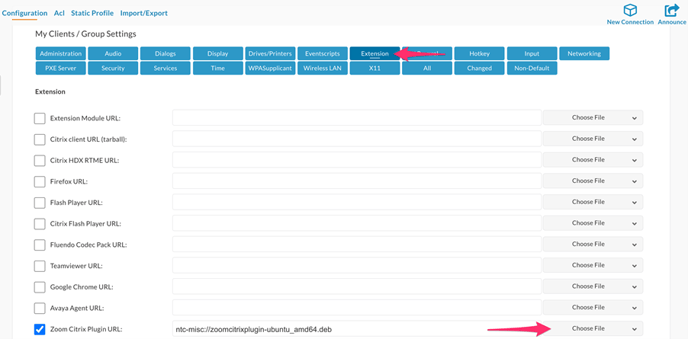
If your NoTouch Center instance is using a self-signed certificate, please ensure that ‘Check Certificates on System Downloads’ is turned off.

Please announce the change to your endpoints, and a reboot will be required for the changes to take effect.
Finally, from a Stratodesk perspective, you will then need to enable Zoom plugin in your connection.

Additional configuration is also required on the VDA, so you will have to ensure that you install the ZoomInstallerVDI.msi rather than the standard Zoom client, and there are also some additional Windows registry options for further optimisation. https://support.zoom.us/hc/en-us/articles/360032343371
Further resources are available at https://support.zoom.us/hc/en-us/articles/360031096531-Getting-Started-with-VDI#h_dd3fcd42-7fa3-46d1-b553-f19b56988dee
Printing
Printing works fine with Citrix in NoTouch. Please consult our Printer configuration page.
Smartcard support
Citrix can forward smartcard readers and use these for login purposes. U.S. Federal customers will enjoy the CAC card support. In that case, do not forward the smartcard reader with generic USB forwarding. Configure smartcard support according to these instructions:
- Switch on the "Smartcard service (PCSCD)" in the "Services" options
- In most cases the default settings for the Smartcard driver parameter will be fine. Some readers need the Omnikey setting, not only Omnikey readers. You may have to experiment with that or contact support.
- Set the "Smartcard login" parameter in the Citrix parameters to "on"
Note: For XenDesktop, do not attempt to use the generic USB forwarding mechanism to forward the smartcard reader (it won't be default, you would have to play with the settings). The downside is that then you can't use the reader for login purpose. It would work to forward a reader into the session only (ie without login) if that is what you want.
Advanced configuration
NoTouch comes with reasonable default values and should accommodate all Citrix options that are used by 99% of the people. However sometimes even deeper configuration accesses are necessary. NoTouch comes with an easy-to-use method of modifying Citrix INI files: Citrix Receiver configuration files
Furthermore, you can totally rewrite the files that are used to generate the Citrix configuration, which would work by the template mechanism.
Selecting the Citrix Receiver version
Most NoTouch images have at least two Citrix Receiver versions included. Yes, you read that correctly, two different versions of the Citrix product, so you can select the one that fits your use case better. By default, the newer client will be used.
To switch to an alternative version of the Citrix Receiver, use the "Client version (if present)" parameter in the Citrix Workspace App options. You may have to scroll down a bit to find it, it is pretty far down below.
Proxy settings
The Citrix Receiver can connect via a proxy server. While these parameter may seem obvious, it is important to note that from OS 2.40.1310 on the Citrix Receiver will inherit the Firefox proxy settings of the same connection, if you switch the "Use Firefox proxy settings" parameter to on. This will inherit exactly your NoTouch settings that you made in the "Firefox" parameters.
Certainly you can configure the proxy settings directly and even specify to inherit from the system-level proxy settings. Here are the parameters in more detail:
- Use Firefox proxy settings. If set to on, all parameters below will be ignored and the Firefox configuration parameters of the same connection will be evaluated.
- Proxy type. Master switch denoting the kind of proxy configuration used:
- No setting. Do not mention anything about proxy in the Citrix configuration files.
- None. No proxy is to be used.
- System settings. The system-level proxy settings will be used.
- Auto config (Script). The system will download a .pac file from the "Proxy autoconfig URL" and evaluate it.
- Secure Host. Think of this as the "manual configuration". The system will use the "Proxy hostname" parameter and the "proxy bypass list".
- SOCKS. Uses the "proxy hostname" as a SOCKS proxy.
- Proxy hostname. Hostname:port combination of the proxy server to be used. It must be configured to accept HTTPS traffic.
- Proxy bypass list. A comma-separated list of hostnames and IP addresses that Receiver will always contact directly.
- Proxy autoconfig URL. A URL to the .pac file providing proxy auto-configuration, if the Proxy type parameter is set to "Auto config (Script)".
- Fallback to direct if no autoconfig received. In case the autoconfig URL (see above) can not be reached, Receiver will connect directly. This can be useful if people are traveling.
Citrix considerations
Citrix has a lot of options, some combinations may have strange effects. Most people are fine with the defaults, in fact Stratodesk recommends to change something only when a) necessary and b) advised to do so. Stratodesk can not provide support for Citrix installation, be sure to have a Citrix professional at hand when troubleshooting.
More detailed information can be found in Citrix Workspace App eDocs - you can skip the part about installation and integration, since this is already done in NoTouch.
Also please check out the Citrix Receiver Feature Matrix.
In case something does not work as expected, always open a Citrix support case before contacting Stratodesk.
Citrix Logging \ Logs
With NoTouch OS 3.4.95+ images there is advanced Citrix logging capabilities. This can be launched via elevated privileges from a command line or executed via a Desktop Custom command.
Command Line
/ICA/util/setlog
NoTouch Center
On the target device, create New Connection, for Connection Mode select - Custom Command
In the Command field enter /ICA/util/setlog
Or
This command will do the same, but set the log values to verbose
/ICA/util/setlog level all verbose; /ICA/util/setlog
.png?width=688&height=107&name=image%20(24).png)
After executing the command via Command Line or Custom connection you will see the setlog utility
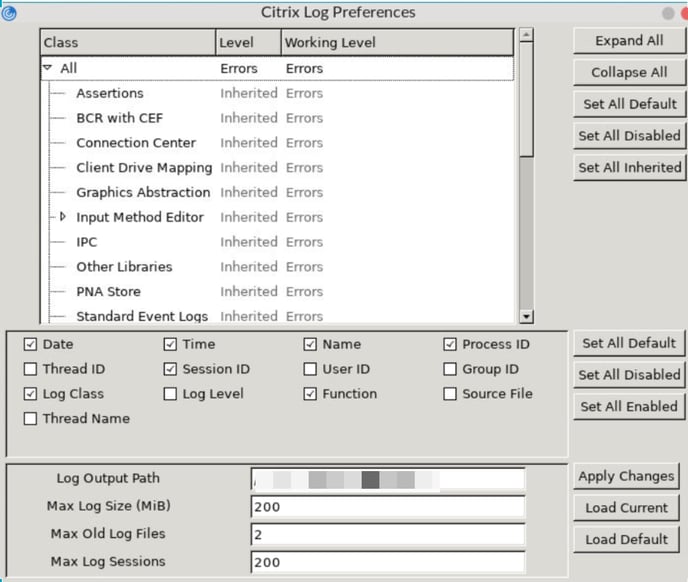
Launch your Citrix client and the log files will be generated, in the /commands/Logread.txt file in the Stratodesk Support file.
